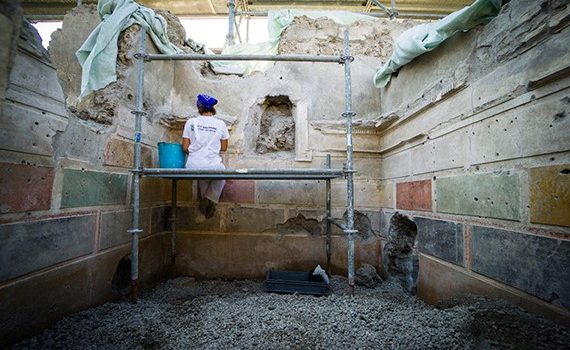Frescoes in the First Style in the House of Jupiter
Frescoes in the First Style in the House of Jupiter, traces of fire and charred finds, and a sacro-idyllic picture
News from Regio V
The complete structure of Domus continue to take shape, with precious frescoes, objects and traces of everyday life. Advances continue in Regio V of the Pompeii excavations, where discoveries of structures and finds continue to be made on a daily basis.
One of these rich dwellings is the House of Jupiter, which is emerging along with all of its decorated rooms.
The House was already partially excavated between the eighteenth and nineteenth centuries, and somewhat compromised in various locations by still-visible tunnels and trenches which were dug as part of excavations in the Bourbon era. The name of the House derives from a small painting depicting Jupiter, which was discovered in the 19th century on a lararium located in the garden.
The current intervention is gradually sketching out the plan of a dwelling with a central atrium, surrounded by decorated rooms, with an entrance along Vicolo dei Balconi - which was itself recently discovered - and an open colonnaded space at the back onto which three other rooms face.
The reception rooms around the atrium have revealed a rich decoration in the First Style, with stucco squares imitating marble slabs (crustae) painted in bright colours (red, black, yellow and green), along with a rich stucco frame with serrated moulding which has been preserved in certain sections along the upper part. The atrium itself was probably completed by a stucco Doric frieze, with a red and blue finish, as evidenced by numerous fragments discovered in various locations.
It is highly likely that the house deliberately kept the older First Style decoration in the reception rooms, whereas other Pompeian residences often saw it replaced by more modern decorations.
Traces of a fire have however been found, in a room of the domus bordering the adjacent House of the Silver Wedding, which had already been mostly investigated in the past. The fire blackened the frescoed wall, which also incorporated furnishings, possibly including a bed, as would seem to be indicated by fragments of wood and charred cloth.
A beautiful little sacro-idyllic painting, which depicts a scene of sacrifice near a rustic sanctuary has, however, emerged in a room not far from the House of Jupiter, in what is currently identified as the House to the North of the garden. The painting reveals one of the earliest figurative scenes of a certain complexity, along with a painting of the wounded Adonis with Venus and Cupids, which had already been discovered in a nearby alcove.
(Photographs by Cesare Abbate)


